
Top 25 Rankings 1901-1935
1914 National Championship
Home
1914
College Football Top 25

Pictured above is the Yale Bowl on its opening day, November 21st, 1914. Its
bowl-shaped design would be emulated by football stadiums thereafter, most
notably by the Rose Bowl, which borrowed not only its design but its name as
well. The Yale Bowl is thus the root reason we call postseason football games
"bowl" games today, and is perhaps the actual
"Granddaddy of them all." When it opened, the Yale Bowl was by far the
biggest stadium in America, and a record 70,000 spectators came to watch Harvard
deliver Yale her worst beating ever, 36-0.
And
this was a very strong Yale team. They finished 7-2, their other loss
coming 13-7 to 10-1 Washington & Jefferson (who also lost to
Harvard), and they beat 8-1 Virginia, 8-1 Lehigh, 6-2 Notre Dame, 5-2-1
Colgate, 5-2-2 Brown, and 5-2-1 Princeton by an average score of 25-5.
Yet Harvard stomped them like a patsy. There can be little doubt that
Harvard's starting lineup was the most powerful football team in
America. Problem is, Harvard's starting lineup only actually started
the first 2 games, against cupcakes. After that, almost every starter
was lost to injury, and Harvard ended up suffering 2 upset ties,
finishing 7-0-2. That left the door open for 7-0 Illinois and 9-0 Army,
whom I think would have battled for #1 in a 1914 AP poll, leaving the
undoubted best team in the country, Harvard, at #3.
I covered these 3 teams and the top of a hypothetical 1914 AP poll in detail in my 1914 national championship article,
and in that article I also summarized 8-0 Texas and 9-0 Missouri
S&T. As I said in the article, Illinois and Army are very hard to
separate for #1, so I'm not going to bother to do so here. They share
#1. Sorry Harvard, but the best team doesn't always win: injuries were and are a part of the game.
Illinois and Army share #1, Harvard #3.
Washington & Jefferson, Yale, Princeton, and Dartmouth
10-1
Washington & Jefferson and 7-2 Yale would easily have been #4 and
#5 in a 1914 AP poll. W&J only lost at #3 Harvard, and by just 1
point, and they won 13-7 at Yale. Yale only lost to #3
Harvard and #4 W&J, and as noted they defeated 5-2-1 Princeton (will be
rated #6), 6-2 Notre Dame (#9), 5-2-1 Colgate (#14), 8-1 Lehigh (#21),
8-1 Virginia (#20), and 5-2-2 Brown (nearly rated). Needless to say,
that is a simply amazing collection of wins, and only the Princeton
game was close.
It is unclear whether an AP poll would have gone with
5-2-1 Princeton or 8-1 Dartmouth next. Princeton defeated Dartmouth
16-12, but it was a close home win, and Princeton was tied by 6-1-1
Williams (#24) at home the next week, Halloween Day. Dartmouth won
21-3 at Williams, and their performance for the season was far better
than that of Princeton. They also beat Syracuse (5-3-2, #16) 40-0,
while Princeton beat them 12-7. I'm going to settle this one with
another tie.
Washington & Jefferson #4, Yale #5, and Princeton and Dartmouth share #6
Washington & Jefferson
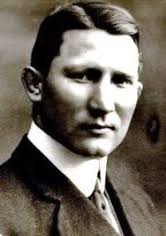
Washington
& Jefferson had gone 10-0-1 the previous season, but this year's
10-1 team was even better, and if not for the 1-point loss at #3
Harvard, they would have been national champions. In addition to
beating #5 Yale, they topped #10 Pittsburgh (8-1) and #17 Rutgers, and
they played all of the aforementioned games on the road. I summarized their titanic struggle with Harvard in the Harvard section of my 1914 national championship article.
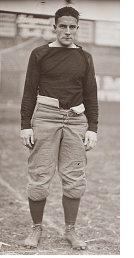 The coach was Bob Folwell, pictured above. If the picture seems familiar, it's because I also used it for my article on the top 25 of 1923, when he was coach of #13 Navy, and I used it again for the 1917 top 25,
when he was coach of #4 Penn. You'll likely be seeing it again at some
point, when he is the coach of strong Lafayette teams 1909-1911 (they
were top 10 in 1909). I summarized his career in the linked 1923
article, but in brief, he was 109-31-9 at 4 schools, which puts him on
the list for best all-time coaching win percentage,
and in 15 of 16 years that he coached, his teams were top 25. He is
somehow not in the Hall of Fame, by far their most egregious omission.
The coach was Bob Folwell, pictured above. If the picture seems familiar, it's because I also used it for my article on the top 25 of 1923, when he was coach of #13 Navy, and I used it again for the 1917 top 25,
when he was coach of #4 Penn. You'll likely be seeing it again at some
point, when he is the coach of strong Lafayette teams 1909-1911 (they
were top 10 in 1909). I summarized his career in the linked 1923
article, but in brief, he was 109-31-9 at 4 schools, which puts him on
the list for best all-time coaching win percentage,
and in 15 of 16 years that he coached, his teams were top 25. He is
somehow not in the Hall of Fame, by far their most egregious omission.
Washington
& Jefferson recruited Folwell away from Lafayette, where he had
gone 22-4-1, and he posted a terrific 36-5-3 record here 1912-1915. In
1912 they tied Jim Thorpe's top 10 Carlisle team, and as noted, in 1913
they went 10-0-1, and were the highest-scoring team in the nation. This
season, after beating Yale, the team received a note of congratulations
from Theodore Roosevelt.
This Washington & Jefferson team
fielded a full 6 starters (of 11) who would make first-team All
American lists in their careers, 4 of them this season. The star was
consensus AA halfback Johnny Spiegel (pictured at left), who had led
the nation in scoring in 1913. Center and captain Burleigh Cruikshank
and tackle Britain Patterson each made 6 first-team AA lists, and end
Reginald Bovill made 1. End Fred Heyman and tackle Maurice Witherspoon
would make first-team AA lists in 1915.
Dartmouth
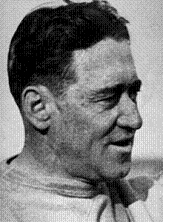
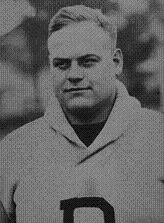
Dartmouth
was coached by Hall of Famer Frank Cavanaugh (pictured above at left),
who played at end here 1896-1897. He went 42-9-3 as coach here
1911-1916, then went 48-14-5 at Boston College 1919-1926, then 34-14-4
at Fordham 1927-1932 (bringing them their first top 25 season in 1930).
Overall he was 145-48-17.
Dartmouth was led on the field by Hall
of Fame guard Clarence "Doc" Spears (pictured above at right), a
consensus AA this year and next. He would succeed Cavanaugh as coach at
Dartmouth, going 21-9-1 over 4 years. He became a doctor, which is why
they eventually called him "Doc," but he continued coaching as well, at
West Virginia, Minnesota, Oregon, Wisconsin, Toledo, and Maryland.
Overall, he was 148-83-14 at the 7 schools.
Quarterback Milt
Ghee made 4 first-team AA lists this season, and later played for the
Canton Bulldogs with Jim Thorpe, winning 2 championships. In 1917 he
threw 17 touchdown passes and was all-pro. Fullback Lawrence Whitney
made 7 first-team AA lists, and had previously won a bronze medal in
the shotput at the 1912 Olympics in Stockholm.
Minnesota, Notre Dame, and Pittsburgh
Coming
in next
in an AP poll would have likely been 6-1 Minnesota, 8-1 Pittsburgh, and
6-2 Notre Dame, in that order. But I'm going to flip Pitt and Notre
Dame here.
6-1 Minnesota took their loss to #1 Illinois, and they defeated #11
Chicago, #12 Wisconsin, 4-3 Iowa (nearly rated), 5-2-1 South Dakota
(nearly rated), and 4-3 Iowa State.
8-1 Pitt took their loss by just 13-10 at home to #4 Washington
& Jefferson, and they defeated #14 Cornell 9-3 on the road and #23
Penn State 13-3 at home. Their problem, compared to Notre Dame, is 2
close wins over teams that wouldn't qualify for a top 40, 6-3 Navy
and 5-9-1 Carlisle. 6-2 Notre Dame took their losses to #1 Army and #5
Yale, and while neither game was close, no one else came within a
touchdown of Notre Dame. They routed #16 Syracuse 20-0 on the road and
5-2-1 South Dakota (nearly rated) 33-0 on a neutral field.
Minnesota #8, Notre Dame #9, and Pittsburgh #10.
Pittsburgh
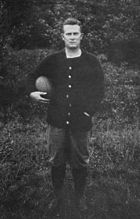
Pittsburgh
was coached by Joseph Duff, Jr., who had been an All American guard at
Princeton in 1911. He went 14-3-2 as coach here 1913-1914, then
graduated from law school in the Spring and left coaching behind. He
was killed in action in WWI. Duff and the players he recruited paved
the way for Pop Warner to come to Pitt in 1915 and proceed to go
unbeaten all the way to 1918, winning a pair of national championships
along the way.
And what a group of players! Hall of Fame center
Bob Peck was the only first-team All American Pitt was recognized for
this year, but 3 more of this year's players would be recognized in
ensuing seasons. Peck would be consensus AA in 1915 and 1916. End James
Herron would be consensus AA in 1916, and halfback Andy Hastings and
guard Claude "Tiny" Thornhill would be nonconsensus AA in 1916.
Hastings
led the team in rushing this year and next, and totaled 1527 yards
rushing and 255 points for his career. Thornhill became a longtime
assistant to coach Pop Warner, and would ultimately be best known as
the head coach for Stanford's "Vow Boys," who won 3 straight PCC titles
1933-1935, and an MNC in 1935. When the Vow Boys graduated, however, Thornhill struggled, and he only ended up 35-25-7 as head coach at Stanford 1933-1939.
Chicago, Wisconsin, and Nebraska
Missouri Valley
champion 7-0-1 Nebraska would have been rated higher than 4-2-1 Chicago and 4-2-1 Wisconsin, and it's a close call, but I
don't think I can allow that. As you might have guessed, Chicago and
Wisconsin tied each other. They each took their pair of losses to #1
Illinois and #8 Minnesota, and each in their last 2 games. Since
Chicago played close in one of those games, and had one close win to 2
for Wisconsin, and because the tie between the two occurred at
Wisconsin, it is easy to rate Chicago higher. Both defeated 2
nearly-rated teams (4-3 Iowa and 5-2 Purdue for Chicago, 5-2 Ohio State
and 5-2 Purdue for Wisconsin).
7-0-1 Nebraska took an upset tie to 5-2-1 South Dakota (nearly
rated) at home. Since South Dakota only lost to #8 Minnesota and #9
Notre Dame, it is conceivable that they were a top 25 team, but due to rest of
their schedule, they accomplished nothing at all aside from tying
Nebraska, so there is no way to know. Nebraska also struggled to beat
6-3 Washburn 14-7 at home. But those games were early. After that,
Nebraska took off, winning 24-0 over 5-2 Michigan State (#22), 20-7
over 4-3 Iowa State, 35-0 over 5-2-1 Kansas, and 16-7 at 4-3 Iowa
(nearly rated). Chicago only beat Iowa 7-0 at home.
Nebraska likely was better than Chicago and Wisconsin this year,
but the problem with rating them higher than those teams is that there
is no way 5-2-1 South Dakota would have been rated in a top 25, and
therefore Nebraska's home tie with them is too big a problem, considering that Chicago and Wisconsin took no upsets.
Chicago #11, Wisconsin #12, and Nebraska #13.
Colgate, Cornell, Syracuse, Rutgers, and Michigan
Here we have a clot of teams that played tough schedules and thus took a bunch of losses and ties: 5-2-1 Colgate, 8-2 Cornell, 5-3-2 Syracuse, 5-3-1 Rutgers, and 6-3 Michigan.
5-2-1 Colgate took their losses to #1 Army and #5 Yale. They were tied
at 5-3-2 Syracuse, but won a huge game 7-3 at 8-2 Cornell. Cornell's
other loss came to #10 Pitt by 6 points, and they crushed all the rest
of their opponents, highlighted by a 28-13 win at 6-3 Michigan.
5-3-2 Syracuse took their losses to #6 Princeton, #6 Dartmouth, and
#9 Notre Dame. In addition to Colgate, they tied 5-3-1 Rutgers (both
games at home). Like Cornell, their big win came against 6-3 Michigan,
won 20-6 at home.
5-3-1 Rutgers took their losses to #1 Army, #4 Washington &
Jefferson, and #6 Princeton, and as noted, they tied Syracuse on the
road. They did not, however, defeat a top 25 team, their best win
coming 16-7 over 5-3 Tufts (nearly rated) on a neutral field. But they
get the nod over Michigan here because they tied Syracuse, where
Michigan lost.
6-3 Michigan took their losses to #3 Harvard and to the
aforementioned Cornell and Syracuse. Their one big win came 3-0 at 5-2
Michigan State (#22).
Colgate #14, Cornell #15, Syracuse #16, Rutgers #17, and Michigan #18.
Texas and Virginia
Here
come the first of this year's token teams, 8-0 Texas representing the
Southwest, and 8-1 Virginia representing the South. 8-0 Texas smashed
all of their opponents, including 32-7 over 9-1-1 Oklahoma. I
summarized them in my 1914 national championship article. This is their first-ever top 25 team.
8-1 Virginia lost to #5 Yale, but they smashed the rest of their
opponents, including 20-3 over 10-1 North Carolina (nearly rated).
Texas #19, Virginia #20.
Lehigh, Michigan State, Penn State, and Williams
It's not at all
clear which teams a 1914 AP poll would have rated next, but the above-listed four
teams would have been candidates for the slots, and due to a pair of huge ties, we're going with
them:
8-1 Lehigh, 5-2 Michigan State, 5-3-1 Penn State, and 6-1-1 Williams.
The "huge ties" obviously belonged to Penn State and Williams, and
those ties came against #3 Harvard and #6 Princeton.
8-1 Lehigh took their loss to #5 Yale, and their big win came 20-7
over Penn State. 5-2 Michigan State took their losses to #13 Nebraska
and to #18 Michigan (by just 3 points), and they also notched their one
big win over Penn State, edging them 6-3 on the road. Since Lehigh
performed a bit better against that common opponent, and they also had the better straight record, we'll rank them
higher.
In addition to
Lehigh and Michigan State, 5-3-1 Penn State lost at #10
Pittsburgh. PSU's big "win" was a 13-13 tie at #3 Harvard. Their best actual win came 17-0 at 5-3-2 Lafayette, who wasn't close to top 25, so the bulk of what
PSU really accomplished this season was that tie at Harvard. And in
truth, due to massive injuries for Harvard, the tie was earned mostly against Harvard's substitutes (this game is summarized
in the Harvard section of my 1914 national championship article). But a tie with Harvard's substitutes on the road is still more than almost all of the teams covered below accomplished.
6-1-1
Williams lost at #6 Dartmouth 21-3, but they brought home their own big
"win" with a 7-7 tie at #6 Princeton. Their best actual win came 17-13
over 6-3 Springfield (nearly rated), who lost to #1 Army by only a
touchdown. But Williams posted close wins over poor teams, 2-6-1
Vermont and 4-2-1 Trinity (Connecticut), while all of PSU's wins came
by more than a touchdown, so we'll rate PSU higher.
Williams wasn't a one-hit wonder:
we'll see them again when I do the 1912 top 25. Their star player this
year was halfback Andrew Toolan, who made a list of the season's best
players published by Outing magazine. He enabled the 7-7 tie at
Princeton with a 55 yard run to set up his touchdown pass.
Lehigh #21, Michigan State #22, Penn State #23, and Williams #24.
Last Slot: Washington & Lee vs. Washington
There
are a lot of teams that we could look at for this last spot in the
top 25, but I think a 1914 AP poll would have come down to 9-0
Washington & Lee vs. 6-0-1 Washington. Washington & Lee had
gone 8-1 in both 1912 and 1913, and Washington was unbeaten this year
for the 7th straight season, so the football world was already paying
attention to these teams before the season had started.
My problem here is
with 9-0 Washington & Lee. Their best win came 7-6 over 6-2-1 Virginia
Tech on a neutral field, but VT was not close to top 25, so W&L
accomplished very little, and they struggled twice more in defeating
mediocre 5-4 West Virginia and 3-3-1 North Carolina State. Though they appear to have received
more attention from the press than did 9-0 Tennessee, very little separates these teams, and when
we do split hairs, Tennessee comes out on top in comparison. In fact, I
can't find even one argument, however tenuous, for rating W&L ahead
of Tennessee. Tennessee had a slightly better average margin of
victory, they played more winning teams (5, while W&L played 3 plus
2 .500 teams), and they had 2 close wins to 3 for W&L. I'd be inclined to rate Tennessee higher. But both of these teams were very unimpressive.
West
Coast champion 6-0-1 Washington, as noted, went unbeaten for the 7th
straight season, and though they were tied by 7-0-2 Oregon State at a neutral
site, no other team came within a touchdown of them. Now, the problem is, there
was no real connection between the Northwest teams and the rest of the
country, so there is no sure way to gauge how strong this region was. No data from this season,
anyway. The region would prove itself with big intersectional wins over
the next 2 seasons, and as such, it is probable that Washington, as
well as 7-0-2 Oregon State, were better than their ratings
this season. Oregon State will rout this year's #22 team, Michigan State, on the road in 1915, for MSU's only loss.
Naturally,
however, I'd rather not be rating teams based on what they do in
ensuing seasons. The real point here is that Washington & Lee
performed poorly too often, so I'm going with Washington for this last
slot.
Washington #25.
Others
Receiving Votes
Here
are the teams closest to making this top 25. For the 1915 top 25, we
only had 5 teams on this list, but for this season, we have an
explosion to 14 teams. Obviously this was a very deep year for strong
football teams nationwide, and therefore a much more difficult top 25
to get into than the top 25 of many of the seasons that followed. Western Michigan
went 6-0 this season, but their schedule was too low-level for
consideration for this list.
Washington & Lee 9-0
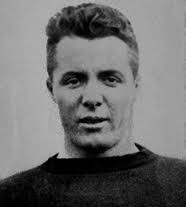
As
covered above, 9-0 Washington & Lee didn't beat anyone of much
value, and they had 3 close wins over unrated opponents. They did score
103 points on Morris Harvey, now known as the University of Charleston,
but overall W&L was not nearly as impressive as, for example, 9-0
Missouri S&T (covered below), who didn't qualify for a spot in the
top 25 themselves.
Coaching Washington & Lee was Walter "Jogger" Elcock, who had played
tackle for Dartmouth 1909-1911. He went a terrific 21-3-3 here
1914-1916, and though he went 9-0 this
year, 7-1-1 in 1915, and 5-2-2 in 1916, the 1916 edition was actually
his best team. That team played a vastly more ambitious schedule than this
year's edition did, losing by 7 to #3 Army and by 4 to #16 Washington
& Jefferson, tying 8-0-1 Georgia Tech, and winning 10-0 over 6-3-1
Navy. It's the only team of his that made the top 25.
Tackle Ted Schultz was a nonconsensus AA this year, and
would be team captain in 1915. The star player, though, was Hall of
Fame halfback Harry "Cy" Young (pictured). This guy could not get enough of
college football, playing for Marshall 1910-1911, for Michigan's
freshman team in 1912, and for Washington & Lee 1913-1916. He led
W&L in scoring all 4 years he was here, tallying 57 points
this season. W&L was 29-4-3 during his time here, and he was team
captain in 1916, as well as president of his class. But football wasn't
his only game, and he won a total of 16 letters in 4 sports at W&L.Tennessee 9-0
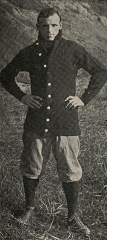 Similar to 9-0 Washington & Lee, 9-0 Tennessee didn't beat
anyone of any value, and they had 2 close wins over unrated opponents.
One of those was a pretty big deal for Tennessee, 16-14 over Vanderbilt, who
had been ruling the South, but Vanderbilt was only 3-6 this season, so
there was no value in it as far as getting into a top 25 is concerned.
Their first top 25 finish will come 2 years later, when they beat a 7-1-1 Vanderbilt team.
Similar to 9-0 Washington & Lee, 9-0 Tennessee didn't beat
anyone of any value, and they had 2 close wins over unrated opponents.
One of those was a pretty big deal for Tennessee, 16-14 over Vanderbilt, who
had been ruling the South, but Vanderbilt was only 3-6 this season, so
there was no value in it as far as getting into a top 25 is concerned.
Their first top 25 finish will come 2 years later, when they beat a 7-1-1 Vanderbilt team.
Tennessee was coached by Zora Clevenger (pictured), who had played halfback
for mediocre-to-poor Indiana teams 1900-1903. Oddly enough, he is
enshrined in the Hall of Fame as a player, an honor that was "earned,"
as far as I can tell, by his being an influential athletic director at
Indiana 1923-1946. He went 26-15-2 as coach of Tennessee 1911-1915, and
then he left for Kansas State, KSU coach John "Chief" Bender coming
to Tennessee in swap. Clevenger went 19-9-2 at KSU 1916-1919, and
overall he was 47-32-7 at 3 schools.
Tennessee won the SIAA this year, their first-ever conference title. Tackle
Farmer Kelly was the captain, and he was All-Southern and listed by
Outing magazine as one of the nation's top players. End Graham Vowell,
who scored 3 touchdowns in a 23-6 win over 5-3 Kentucky this year,
would be captain of Tennessee's 1916 team that first made the top 25,
and he would be All-Southern that year and make Walter Camp's 3rd team
AA list.
Missouri S&T 9-0
I covered Missouri S&T, then known as "Missouri School of Mines" or "Rolla" (the town where the school is located) in my 1914 national championship article.
They outscored their opponents by a crazy 569-6, topping Missouri 9-0
and Arkansas 44-0. This is the team from this list that I came closest
to ranking in the top 25. I would certainly rank them in my own top 25,
as they definitely outperformed #19 Texas, as one example. But these
top 25 lists are based on hypothetical AP polls, and I don't think
enough writers would have been aware of Rolla to rank them in 1914. And
their schedule was mostly "lower-division" in nature, so there is some reason not to rank them.
Oregon State 7-0-2
7-0-2 Oregon
State tied #25 Washington (6-0-1) on a neutral field. Their other tie
came in a home game with 4-2-1 Oregon, who lost to Washington and to a
semi-pro athletic club. Oregon and Oregon State both make the top 25
for 1915, and both might well have been top 25 caliber this year as
well, but we'll never know.
Auburn 8-0-1
Auburn's 8-0-1 finish in 1914 was coming on the heels of their terrific 8-0 finish the year before.
Their best wins this year were 19-0 over 6-2 Mississippi State in
Birmingham and 14-0 at 6-2 Georgia Tech, but they suffered a tie to
3-5-1 Georgia in Atlanta, and they performed poorly in close wins over
3-6 Vanderbilt and 5-9-1 Carlisle.
Colorado Mines 5-0-1
5-0-1
Colorado Mines was this year's Rocky Mountain champion. They were tied
at 4-1-1 Colorado College, but they secured the title with a 6-2 win
over 5-1 Colorado at home. Colorado Mines was coached by William "Bo"
Hanley, who went 9-2-1 here 1914-1915. He had played tackle for
Marquette's 1909 team that garnered some bit of national (or at least
regional) acclaim for tying 7-0-1 Notre Dame, and he had been known as
the "Marquette Marvel" there. Hanley left coaching behind to
become a doctor, but he did play some professional football in the
1920s on the side.
Springfield 6-3
Springfield (Massachusetts) was never quite Top 25
caliber, though they came close a few times. This was the last time. The losses were 44-0 at #3 Harvard (ugly), 13-6 at #1 Army
(terrific), and 17-13 at #24 Williams (good showing). They didn't beat
anyone of any value, but all of their wins came by more than a
touchdown.
South Dakota 5-2-1
5-2-1
South Dakota has a very strong argument for inclusion in the top 25,
simply because they tied 7-0-1 Nebraska (#13) and they took no upset
losses. Still, their losses were ugly, 33-0 to #9 Notre Dame and 29-7
to #8 Minnesota, they posted an uglier 9-7 win over 5-4 Creighton at
home (Creighton lost to Haskell 38-0, who lost to #19 Texas 23-7), and
the rest of their wins were completely worthless. As such, it is easy
to write their Nebraska tie off as an anomaly.
Ohio State 5-2
5-2
Ohio State lost 37-0 at #1 Illinois and 7-6 to #12 Wisconsin at home,
the latter their best result of the season. They did not beat a team of
any value, and they performed poorly in a 7-6 win at 4-6 Case.
Purdue 5-2
5-2
Purdue lost 21-0 at #11 Chicago and 14-7 at #12 Wisconsin, so like Ohio
State, they gave Wisconsin a good game. Their schedule wasn't much
better than Ohio State's, but they did beat 5-3 Kentucky 40-6 (9-0
Tennessee beat them 23-6), and unlike OSU, Purdue had no close wins.
Might have been a top 25 team power-wise. Their coach, Hall of
Famer Andy Smith, would win national championships at Cal in the 1920s.
Iowa 4-3
4-3
Iowa may have been the best of this trio of Big 10 teams outside the
top 25. They lost by just 7-0 at #11 Chicago, 7-0 at #8 Minnesota, and
16-7 at #13 Nebraska, and their wins were dominating, including a 26-6
win at 4-3 Iowa State. They scored 95 on Northern Iowa. Their coach,
Jesse Hawley, would win a national championship at Dartmouth in 1925.
Brown 5-2-2
5-2-2 Brown's
great triumph this season was a tie with the 2nd and 3rd team players
of #3 Harvard, who rested their starters against Brown so that they would be
fresh against archrival Yale the next week. Brown's great debacle this
season was a tie with 2-4-2 Amherst. Their losses came to #5 Yale and
#15 Cornell. Brown did not beat a good team, and they struggled to get
past 2-6-1 Vermont 12-9 and 5-9-1 Carlisle 20-14.
North Carolina 10-1
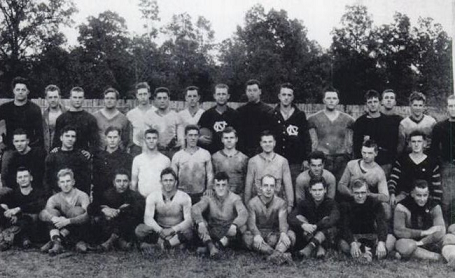
10-1 North Carolina took their loss 20-3 at #20 Virginia. Their big
win was 16-3 over 5-1-1 Davidson on a neutral field. They generally put
up big scores in the rest of their games, but posted 2 poor
performances, 10-9 at 3-6 Vanderbilt and 12-7 over 3-6 Wake Forest on a
neutral field.
The coach was Thomas "Doggie" Trenchard, who had
been an All American end at Princeton way back in 1893. He had coached
North Carolina to a 7-1-1 record in 1895, and then he came back 18
years later for this short stint 1913-1915 and went 19-8-1, putting his
UNC total at 26-9-2. With short stints at 3 other schools, his career
total was but 34-28-6, so obviously he did his best work at UNC.
The
star player this year was halfback David Tayloe, who made Outing
magazine's list of the nation's best players. He was team captain this
year and next.
Tufts 5-3
5-3 Tufts barely
qualifies for this list. Their most notable accomplishment this season
was playing #3 Harvard close in a 13-6 loss, but Harvard was beset by
injuries at that point in the season, and only 3 of their regular
starters were available for the game. The game was also played in rain
and mud. Tufts
also put in a decent effort in their 16-7 loss to #17 Rutgers, but they
were awful in a 68-0 loss to #6 Dartmouth. Most of Tufts' wins came by
big scores, but they only beat 2-5 Massachusetts 7-6 at home.
1914
Top 25
1) Illinois 7-0
Army 9-0
3) Harvard 7-0-2
4) Washington & Jefferson 10-1
5) Yale 7-2
6) Princeton 5-2-1
Dartmouth 8-1
8) Minnesota 6-1
9) Notre Dame 6-2
10) Pittsburgh 8-1
11)
Chicago 4-2-1
12) Wisconsin 4-2-1
13) Nebraska 7-0-1
14) Colgate 5-2-1
15) Cornell 8-2
16) Syracuse 5-3-2
17) Rutgers 5-3-1
18) Michigan 6-3
19) Texas 8-0
20) Virginia 8-1
21) Lehigh 8-1
22) Michigan State 5-2
23) Penn State 5-3-1
24) Williams 6-1-1
25) Washington 6-0-1
Others
Receiving Votes:
Washington & Lee 9-0
Tennessee 9-0
Missouri S&T 9-0
Oregon State 7-0-2
Auburn 8-0-1
Colorado Mines 5-0-1
Springfield 6-3
South Dakota 5-2-1
Ohio State 5-2
Purdue 5-2
Iowa 4-3
Brown 5-2-2
North Carolina 10-1
Tufts 5-3

 The coach was Bob Folwell, pictured above. If the picture seems familiar, it's because I also used it for my article on the top 25 of 1923, when he was coach of #13 Navy, and I used it again for the 1917 top 25,
when he was coach of #4 Penn. You'll likely be seeing it again at some
point, when he is the coach of strong Lafayette teams 1909-1911 (they
were top 10 in 1909). I summarized his career in the linked 1923
article, but in brief, he was 109-31-9 at 4 schools, which puts him on
the list for best all-time coaching win percentage,
and in 15 of 16 years that he coached, his teams were top 25. He is
somehow not in the Hall of Fame, by far their most egregious omission.
The coach was Bob Folwell, pictured above. If the picture seems familiar, it's because I also used it for my article on the top 25 of 1923, when he was coach of #13 Navy, and I used it again for the 1917 top 25,
when he was coach of #4 Penn. You'll likely be seeing it again at some
point, when he is the coach of strong Lafayette teams 1909-1911 (they
were top 10 in 1909). I summarized his career in the linked 1923
article, but in brief, he was 109-31-9 at 4 schools, which puts him on
the list for best all-time coaching win percentage,
and in 15 of 16 years that he coached, his teams were top 25. He is
somehow not in the Hall of Fame, by far their most egregious omission.





 Similar to 9-0 Washington & Lee, 9-0 Tennessee didn't beat
anyone of any value, and they had 2 close wins over unrated opponents.
One of those was a pretty big deal for Tennessee, 16-14 over Vanderbilt, who
had been ruling the South, but Vanderbilt was only 3-6 this season, so
there was no value in it as far as getting into a top 25 is concerned.
Their first top 25 finish will come 2 years later, when they beat a 7-1-1 Vanderbilt team.
Similar to 9-0 Washington & Lee, 9-0 Tennessee didn't beat
anyone of any value, and they had 2 close wins over unrated opponents.
One of those was a pretty big deal for Tennessee, 16-14 over Vanderbilt, who
had been ruling the South, but Vanderbilt was only 3-6 this season, so
there was no value in it as far as getting into a top 25 is concerned.
Their first top 25 finish will come 2 years later, when they beat a 7-1-1 Vanderbilt team.